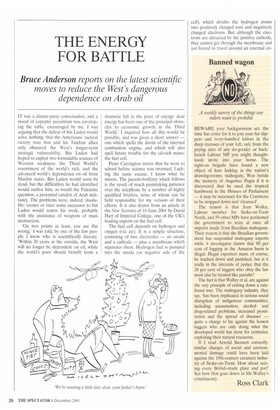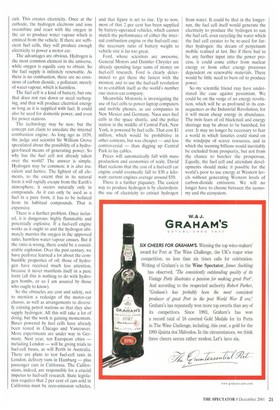THE ENERGY FOR BATTLE
Bruce Anderson reports on the latest scientific
moves to reduce the West's dangerous dependence on Arab oil
IT was a dinner-party conversation, and a mood of eupeptic pessimism was enveloping the table, encouraged by me. I was arguing that the defeat of bin Laden would solve nothing; that the Americans' tactical victory over him and his Taleban allies only obscured the West's longer-term strategic vulnerability. Bin Laden had hoped to exploit two formidable sources of Western weakness: the Third World's resentment of the world's rich, and the advanced world's dependence on oil from Muslim states. Bin Laden would soon be dead, but the difficulties he had identified would outlive him, as would the Palestine question, a perennial catalyst of Arab militancy. The problems were, indeed, insoluble; sooner or later some successor to bin Laden would renew his work, probably with the assistance of weapons of mass destruction.
'On two points at least, you are flat wrong,' I was told, by one of the few people I know who is scientifically literate. 'Within 20 years at the outside, the West will no longer be dependent on oil, while the world's poor should benefit from a dramatic fall in the price of energy: dear energy has been one of the principal obstacles to economic growth in the Third World.' I inquired how all this would be possible, and was given a short answer — one which spells the doom of the internal combustion engine, and which will also spell future trouble for the oil-rich states: the fuel cell.
Peter Carrington insists that he went to school before science was invented. Lacking the same excuse, I know what he means. The pseudo-boffinry which follows is the result of much painstaking patience over the telephone by a number of highly qualified briefers, none of whom can be held responsible for my version of their efforts. It is also drawn from an article in the New Scientist of 16 June 2001 by David Hart of Imperial College, one of the UK's leading experts on the fuel cell.
The fuel cell depends on hydrogen and oxygen (via air). It is a simple structure, consisting of two electrodes — an anode and a cathode — plus a membrane which separates them. Hydrogen fuel is pumped into the anode (or negative side of the cell), which divides the hydrogen atoms into positively charged ions and negatively charged electrons. But although the electrons are attracted by the positive cathode, they cannot get through the membrane and are forced to travel around an external cir cuit. This creates electricity. Once at the cathode, the hydrogen electrons and ions recombine and react with the oxygen in the air to produce water vapour which is emitted from the vehicle. If there are sufficient fuel cells, they will produce enough electricity to power a motor car.
The advantages are obvious. Hydrogen is the most common element in the universe, while oxygen is equally easy to obtain. So the fuel supply is infinitely renewable. As there is no combustion, there are no emissions of carbon dioxide, a pollutant; merely of water vapour, which is harmless.
The fuel cell is a kind of battery, but one that does not run down or need recharging, and that will produce electrical energy as long as it is supplied with fuel. It could also be used for domestic power, and even for power stations.
The technology may be new; but the concept can claim to antedate the internal combustion engine. As long ago as 1839, the judge and scientist Sir William Grove speculated about the possibility of a hydrogen-based means of generating power. So why has the fuel cell not already taken over the world? The answer is simple. Hydrogen may be common; it is also truculent and furtive. The lightest of all elements, to the extent that in its natural form it will rapidly escape from the Earth's atmosphere, it occurs naturally only in compounds. As it can only be used as a fuel in a pure form, it has to be isolated from its habitual compounds. That is expensive.
There is a further problem. Once isolated, it is dangerous: highly flammable and potentially explosive. If a fuel-cell engine works as it ought to and the hydrogen ultimately marries the oxygen in the approved ratio, harmless water vapour ensues. But if the ratio is wrong, there could be a considerable explosion. Over the past century, we have perforce learned a lot about the combustible properties of oil; those of hydrogen have received much less attention, because it never manifests itself in a pure form (all this is nothing to do with hydrogen bombs, or so I am assured by those who ought to know).
So the obstacles are cost and safety, not to mention a redesign of the motor-car chassis, as well as arrangements to diversify existing petrol stations so that they also supply hydrogen. All this will take a lot of doing, but the work is gaining momentum. Buses powered by fuel cells have already been tested in Chicago and Vancouver. More experiments are under way in Germany. Next year. ten European cities — including London — will be giving trials to fuel-cell buses, as will Perth in Australia. There are plans to test fuel-cell taxis in London, delivery vans in Hamburg — plus passenger cars in California. The Californians, indeed, are responsible for a crucial impetus to fuel-cell research. State legislation requires that 2 per cent of cars sold in California must be zero-emission vehicles, and that figure is set to rise. Up to now, most of that 2 per cent has been supplied by battery-operated vehicles, which cannot match the performance of either the internal combustion engine or the fuel-cell one: the necessary ratio of battery weight to vehicle size is far too great.
Ford, whose scientists are awesome, General Motors and Daimler Chrysler are already spending large sums of money on fuel-cell research. Ford is clearly determined to get there the fastest with the mostest, and to use the fuel-cell revolution to re-establish itself as the world's number one motor-car company.
Meanwhile Motorola is investigating the use of fuel cells to power laptop computers and mobile phones, as are companies in New Mexico and Germany. Nasa uses fuel cells in the space shuttle, and the police station in the middle of Central Park, New York, is powered by fuel cells. That cost $1 million, which would be prohibitive in other contexts, but was cheaper — and less controversial — than digging up Central Park to lay cables.
Prices will automatically fall with mass production and economies of scale. David Hart reckons that the cost of a fuel-cell car engine could eventually fall to $30 a kilowatt: current engines average around $50.
There is a further piquancy. The easiest way to produce hydrogen is by electrolysis: the use of electricity to extract hydrogen from water. It could be that in the longerrun, the fuel cell itself would generate the electricity to produce the hydrogen to run the fuel cell, even recycling the water which the fuel cell creates to be re-used for further hydrogen: the dream of perpetuum mobile realised at last. But if there had to be any further input into the power process, it could come either from nuclear energy or from other energy processes dependent on renewable materials. There would be little need to burn oil to produce power.
So my scientific friend may have understated the case against pessimism. We could be on the verge of an energy revolution, which will be as profound in its consequences as the Industrial Revolution, for it will mean cheap energy in abundance. The twin fears of oil blackmail and energy shortage may be about to be banished, for ever. It may no longer be necessary to fear a world in which fanatics could stand on the windpipe of scarce resources, and in which the teeming billions would inevitably be excluded from prosperity, but not from the chance to butcher the prosperous. Equally, the fuel cell and attendant developments should make it possible for the world's poor to use energy at Western levels without generating Western levels of carbon-dioxide emissions. We will no longer have to choose between the economy and the ecosystem.























































































 Previous page
Previous page